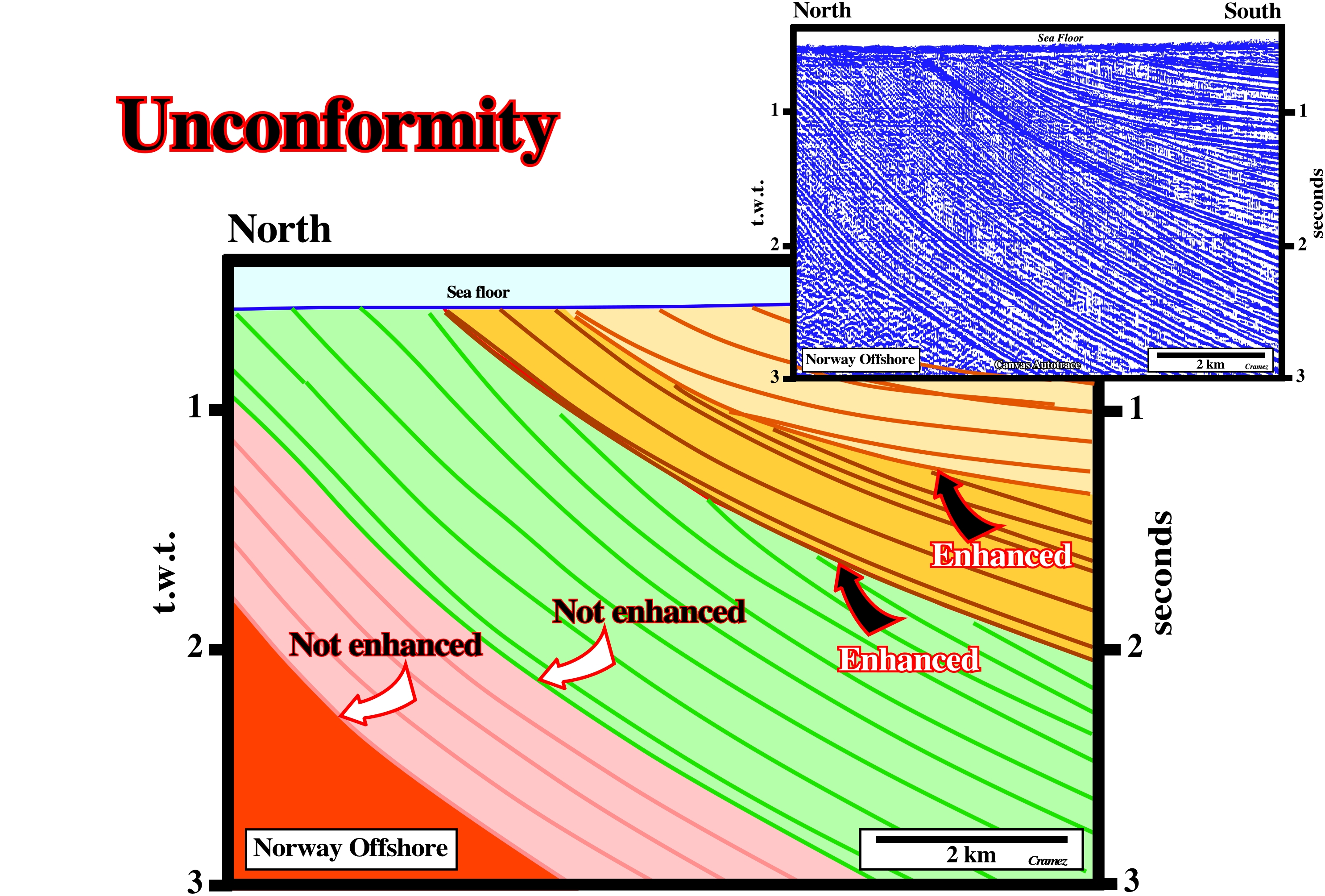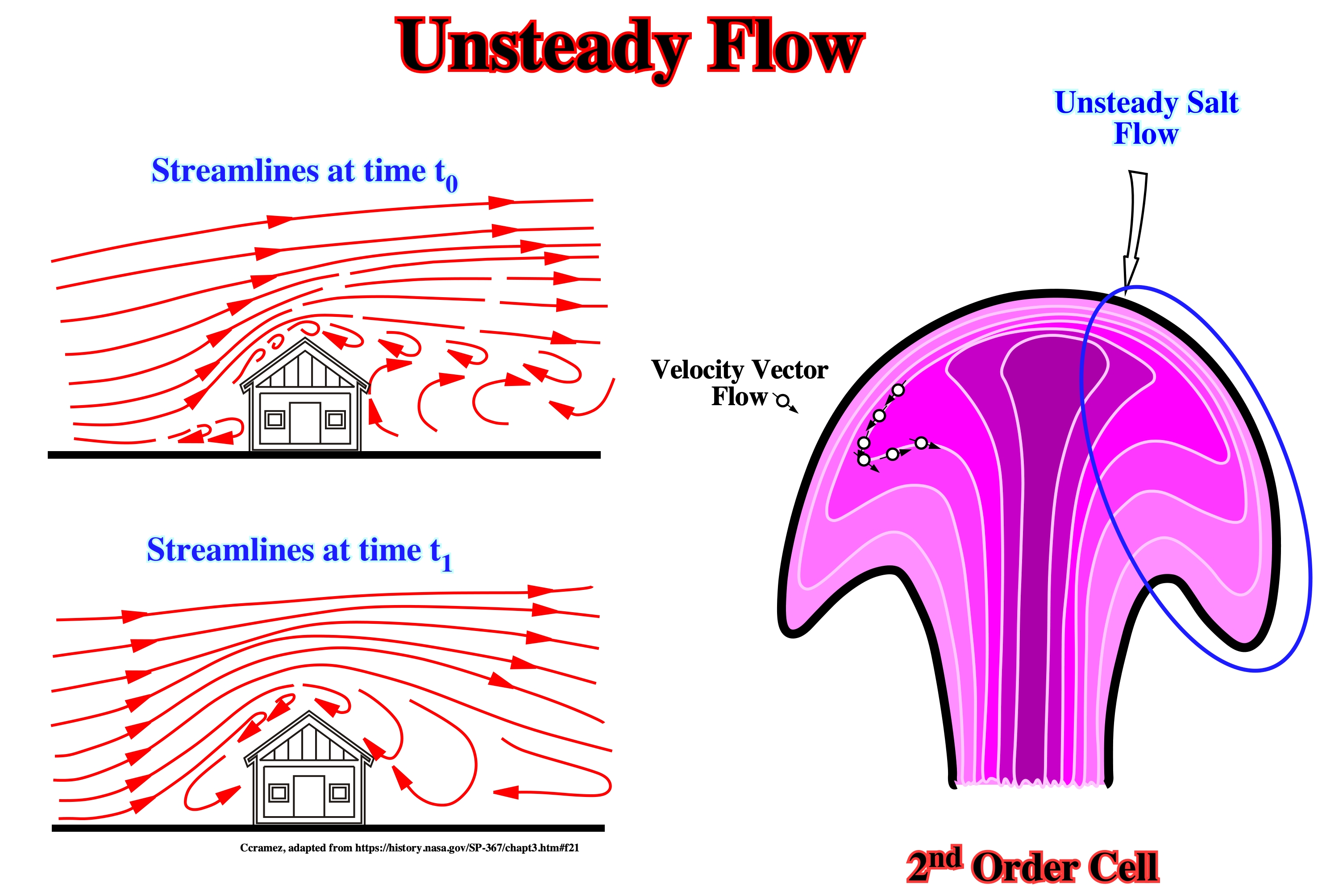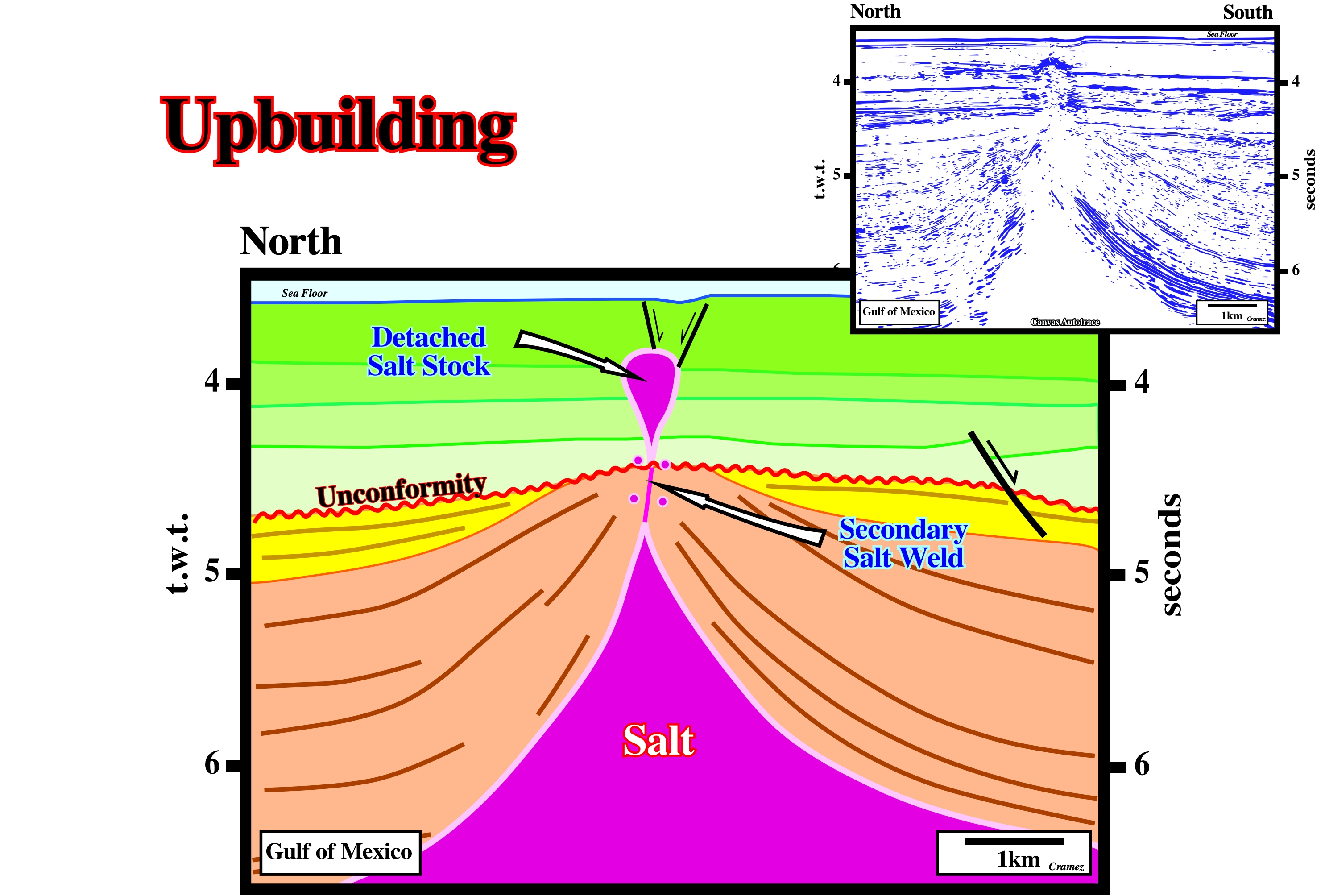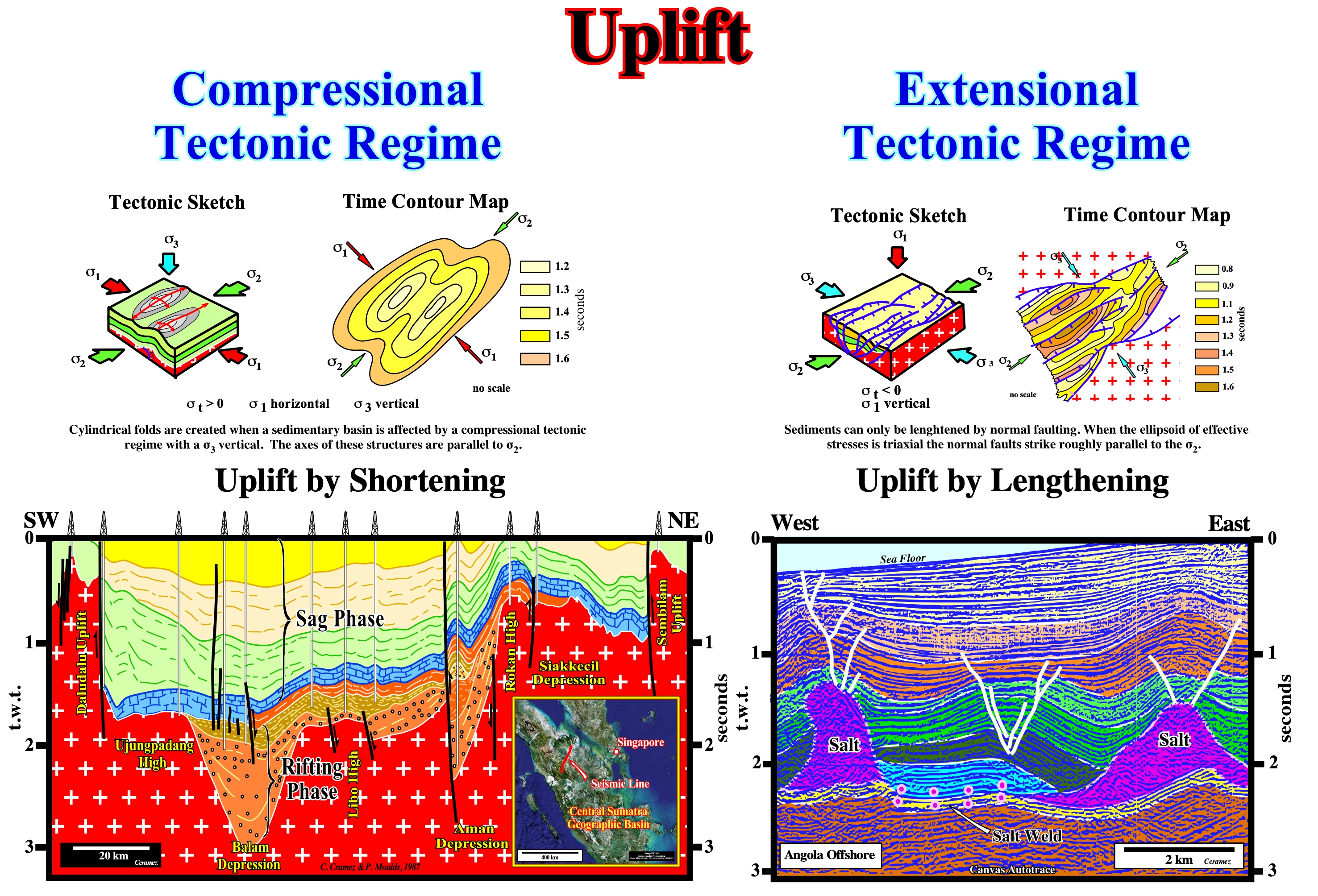

Unconformity
Surfaces characterized by onlap or toplap geometric relationships. Unconformity time-gaps may represent simply prolonged periods of subaerial exposures with minimal erosion, possibly with local valley or channel down-cutting. They may represent periods of uplift and major sub-aerial erosion of strata, or they may represent submarine erosion by turbidites, slump or submarine currents.

On this tentative geological interpretation of a Canvas autotrace of Norway offshore seismic line, several unconformities can be, easily, recognized by onlap and toplap (truncation) geometrical relationships. These unconformities limit stratigraphic cycles associated with 2nd order eustatic cycles.
Uniaxial Ellipsoid
Ellipsoid with an unique axis. An uniaxial ellipsoid corresponds to a sphere. The hydrostatic pressure can be represented by a uniaxial ellipsoid stress.

The hydrostatic or pore pressure acts in opposite sense than the geostatic pressure. One can speak in effective vertical pressure,i.e., the lithostatic pressure reduced by hydrostatic pressure.
Unsteady Flow
When flow pattern varies with time. Streamlines cross layering and deflect it as flow-folds.

A flow in which quantity of liquid flowing per second is not constant, is called unsteady flow. Unsteady flow is a transient phenomenon. It may be in time become steady or zero flow. For example when a valve is closed at the discharge end of the pipeline. Thus, causing the velocity in the pipeline to decrease to zero. In the meantime, there will be fluctuations in both velocity and pressure within the pipe. Unsteady flow may also include periodic motion such as that of waves of beaches. The difference between these cases and mean steady flow is that there is so much deviation from the mean. And the time scale is also much longer. It is important to note the differences between a particle pathline and a streamline. A pathline refers to the trace of a single particle in time and space whereas a streamline presents the line of motion of many particles at a fixed time. The question of whether particle pathlines and streamlines are ever the same is considered next. A steady flow is one in which all conditions at any point in a stream remain constant with respect to time or A steady flow is the one in which the quantity of liquid flowing per second through any section, is constant. This is the definition for the ideal case. True steady flow is present only in laminar flow. In turbulent flow, there are continual fluctuations in velocity. Pressure also fluctuate at every point. But if this rate of change of pressure and velocity are equal on both sides of a constant average value, the flow is steady flow. The exact term use for this is mean steady flow. Steady flow may be (i) Uniform or (ii) Non-uniform. A truly uniform flow is one in which the velocity is same at a given instant at every point in the fluid (this definition holds for the ideal case ; whereas in real fluids velocity varies across the section, But when the size and shape of cross section are constant along the length of channels under consideration, the flow is said to be uniform. A non-uniform flow is one in which velocity is not constant at a given instant. Steady flow compared with unsteady flow.- Of basic importance in understanding fluid movements about an object is the concept of a "steady flow." On a windy day a person calls the wind steady if where he stands it blows constantly from the same direction at a constant speed. If, however, the speed or direction changes, the wind is "gusty" or unsteady. In a similar manner the flow of a fluid about an object is steady if its velocity (speed and direction) at each point in the flow remains constant - this does not necessarily require that the velocity be the same at all points in the fluid.
Upbuilding
Postdepositional diapir growth (in the most extreme or ideal form) through prekinematic overburden. Thus, as the structure increases in relief by growing upward, its base remains at a constant depth, while its crest rises toward the sediment surface. More commonly, diapirs grow by combination of the ideal end members of active and passive piercement because sediments accumulate while the diapir works its way to the surface. This kind of active piercement involves forceful intrusion, which is probably possible only in relatively tall diapirs overlain by relatively thin overburden, unless the overburden is being extended or is fluid or usually weak.

This kind of active piercement involves forceful intrusion, which is possible only in relatively tall diapirs overlain by relatively thin overburden, unless the overburden: (i) is being extended, (ii) is fluid or (iii) usually weak. The normal faults on the top of the detached salt stock, which affect the sea floor, suggest after a period of passive diapirism, it becomes active.
Uplift
A structurally high area in the crust produced by positive movements that raise or upthrust the rocks. Presently, the term uplift is used to express any kind of upward movement.

The onshore of Sumatra Island (Indonesia) corresponds to the stacking of several basins from the classification of the sedimentary basins of Bally and Snelson (1980) which from the bottom up are: (i) Basement or flattened Mountain Folded Belt and (ii) Backarc basin, within which two sedimentary tectonic phases can be evidenced: a) Lengthening or Rifting characterized by a differential subsidence that induced halfgrabens and b) A Sag phase characterized by a thermal subsidence. On the tentative of geological interpretation of a Canvas autotrace of a composite seismic line of the northern of the Sumatra Island (Indonesia), it is evident that the sediments of backarc basin were shortened by a compressional tectonic regime. Such a tectonic regime is characterized by an ellipsoid of the effective stresses (geostatic pressure σg + pore pressure σp + tectonic vector σt) with the main axis (σ1) horizontal and the smallest (σ3) vertical. The structures responsible for the shortening are cylindrical folds and reverse faults, which, for the most part, correspond to the reactivation of the old normal faults that lengthened the sediments during the rifting phase. As can be seen by the, more or less, constant thickness (without abrupt lateral variations) of the sediments of the sag phase (thermal subsidence that contrasts with the differential subsidence of the rifting phase), it can be said the sedimentary shortening is, practically, post-deposition. This means that the uplift associated the shortening had no influence on the creation of available space for the sediments for the already deposited sediments. Changes of the relative sea level (local sea level referenced to any point on the Earth's surface, which is the result of the combination of tectonics and absolute or eustatic sea level, which is supposed to be global and referenced to the Earth's centre) created the space available for sediments (accommodation), during the sag phase of the backarc basin, were induced, mainly, by relative sea level rises (marine ingressions). However, since the wavelength (cyclicity) of eustatic changes is much greater than that of tectonic changes, they have a predominant cause of the cyclicity of the deposits. Whenever the fall of the relative sea level is, sufficiently, to put it put lower than the basin edge, an erosional surface, i.e., an unconformity, was formed, marking the end of a stratigraphic cycle and the beginning of another. When the shortening is contemporaneous with sedimentation, the thickness of the sedimentary intervals decreases in the areas where there is a uplift, since the water-depth decreases, i.e., that locally, the space available for the sediments decreases relative to other areas. It is easy to see that the vast majority of hydrocarbon traps drilled in this region are structural traps (characterized not only by the rock-reservoir interval having a four-way dip closure, but also the sealing-rock, which means that the reservoir-rock and the sealing-rock have the same geometry and are parallel to each other) and correspond to tectonic inversions, i.e., the old, structural low points became high points following the recent compressional tectonic regime (the petroleum migration parameter and, particularly its age, is very important, since many traps may be post-migration). Thus, almost all rifting normal faults were reactivated as inverse faults with a displacement point, apparently, null in the fault plane. The position of the displacement point, apparently, null depends on the amplitude of the inversion, which is a function of the angle between the σ1 of the compressional regime and the fault plane, as well as the angle between the σ1 and the dip of the fault plane. Obviously, this type of trap requires the migration of the hydrocarbons is posterior to the tectonic inversion. It should not be forgotten that not all tectonic uplifts are induced by a shortening of the sediments (compressional tectonic regime). The uplifts associated with halokinesis and shalokinesis (extensional tectonic regime) correspond to antiforms, on the top of which, normal faults (contemporaneous of lengthening) are necessarily developed to elongate the sediments, which is not the case in anticline structures. In the same area, at the same time, the sediments can not be shortened and lengthened at the same time.
Upthrown Fault Compartment
Synonym of Hangingwall.

On this tentative interpretation of a Canvas autotrace of an Angola offshore seismic line, the lower part of the overburden was lengthened by the salt movement. The lengthening was done by syndepositional growth faults with a sharp thickening in the hangingwalls. In fact, the sediments of the green intervals thick towards the fault planes.